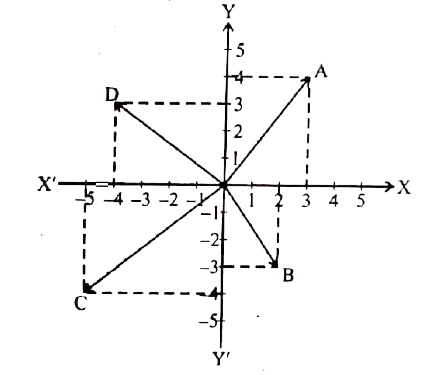Represent the following vectors graphically :
→A=3ˆi+4ˆj,→B=2ˆi−3ˆj:→C=−5ˆi−4ˆj:→D=−4ˆi+3ˆjSolution in Tamil
Topper's Solved these Questions
- BOOK - PREMIERS PUBLISHERSCHAPTER - KINEMATICS EXERCISE - Other important questions & answers (IV. Long answer questions).34videos
KINEMATICS
- BOOK - PREMIERS PUBLISHERSCHAPTER - GRAVITATIONEXERCISE - OTHER IMPORTANT QUESTION & ANSWERS (CONCEPTUAL QUESTIONS)34videos
GRAVITATION
- BOOK - PREMIERS PUBLISHERSCHAPTER - KINETIC THEORY OF GASESEXERCISE - OTHER IMPORTANT QUESTIONS & ANSWERS (VI. Conceptual Questions.)8videos
KINETIC THEORY OF GASES
Similar Questions
Define and illustrate the following terms.
Equal vectors.05:40View SolutionWhy a body weighs less at the equator than at the poles?
03:56View SolutionWhen an automobile travels for a long distance , the air pressure in the tyres increases slightly . Why ?
03:30View SolutionLet →a=ˆj−ˆk and →c=ˆi−ˆj−ˆk . Then vector →b satisfying →a×→b+→c=→0 and →a.→b=3 is (1) 2→i−→j+2→k (2) ˆi−ˆj−2ˆk (3) ˆi+j−2ˆk (4) −ˆi+ˆj−2ˆk
06:27View SolutionFind the volume of the parallelepiped whose coterminous edges are represented by the vectors: →a=2ˆi+3ˆj+4ˆk,→b=ˆi+2ˆj−ˆk,→c=3ˆi−ˆj+2ˆk →a=2ˆi+3ˆj+4ˆk,→b=ˆi+2ˆj−ˆk,→c=3ˆi−ˆj−2ˆk →a=11ˆi,→b=2ˆj−ˆk,→c=13ˆk →a=ˆi+ˆj+ˆk,→b=ˆi−ˆj+ˆk,→c=ˆi+2ˆj−ˆk
05:11View SolutionLet →a=ˆi+ˆj+ˆk,→b=ˆi−ˆj+ˆkand→c=ˆi−ˆj−ˆk be three vectors. A vector →v in the plane of →aand→b, whose projection on →c is 1√3 is given by a.ˆi−3ˆj+3ˆk b. −3ˆi−3ˆj+3ˆk c. 3ˆi−ˆj+3ˆk d. ˆi+3ˆj−3ˆk
03:47View SolutionFind the unit vectors perpendicular to both →a and →b when
(i) →a=3ˆi+ˆj−2ˆk and →b=2ˆi+3ˆj−ˆk
(ii) →a=ˆi−2ˆj+3ˆk and →b=ˆi+2ˆj−ˆk
(iii) →a=ˆi+3ˆj−2ˆk and →b=−ˆi+3ˆk
(iv) →a=4ˆi+2ˆj−ˆk and →b=ˆi+4ˆj−ˆk04:35View SolutionFind the area of the parallelogram whose adjacent sides are represented by the vectors (i) →a=ˆi+2ˆj+3ˆk and →b=−3ˆi−2ˆj+ˆk (ii) →a=(3ˆi+ˆj+4ˆk) and →b=(ˆi−ˆj+ˆk) (iii) →a=2ˆi+ˆj+3ˆkand→b=ˆi−ˆj (iv)→b=2ˆiand→b=3ˆj.
06:00View SolutionRepresent the following vectors graphically :
→A=3ˆi+4ˆj,→B=2ˆi−3ˆj:→C=−5ˆi−4ˆj:→D=−4ˆi+3ˆj02:27View SolutionLet →a=ˆi+ˆj+ˆk,→b=ˆi−ˆj+ˆkand→c=ˆi−ˆj−ˆk be three vectors. A vector →v in the plane of →aand→b, whose projection on →c is 1√3 is given by a.ˆi−3ˆj+3ˆk b. −3ˆi−3ˆj+3ˆk c. 3ˆi−ˆj+3ˆk d. ˆi+3ˆj−3ˆk
11:23View SolutionLet →a=ˆi+ˆj;→b=2ˆi−ˆk. Then vector →r satisfying →r×→a=→b×→a and →r×→b=→a×→b then →r is a.ˆi−ˆj+ˆk b. 3ˆi−ˆj+ˆk c. 3ˆi+ˆj−ˆk d. ˆi−ˆj−ˆk
06:39View SolutionIf →a=3ˆi−ˆj−4ˆk,→b=2ˆi+4ˆj−3ˆk and →c=ˆi+2ˆj−ˆk, find ∣∣3→a−2ˆb+4ˆc∣∣.
05:45View SolutionFind the volume of the parallelepiped whose coterminous edges are represented by the vectors: i,→a=2ˆi+3ˆj+4ˆk,→b=ˆi+2ˆj−ˆk,→c=3ˆi−ˆj+2ˆk ii, →a=2ˆi−3ˆj+4ˆk,→b=ˆi+2ˆj−ˆk,→c=3ˆi−ˆj−2ˆk iii, →a=11ˆi,→b=2ˆj,→c=13ˆk iv, →a=ˆi+ˆj+ˆk,→b=ˆi−ˆj+ˆk,→c=ˆi+2ˆj−ˆk
02:43View SolutionLet →a=ˆj−ˆk and →c=ˆi−ˆj−ˆk . Then vector →b satisfying →a×→b+→c=→0 and →a.→b=3 is (1) 2→i−→j+2→k (2) ˆi−ˆj−2ˆk (3) ˆi+j−2ˆk (4) −ˆi+ˆj−2ˆk
02:29View SolutionLet →a=ˆi+ˆj+ˆk,→b=ˆi−ˆj+ˆkand→c=ˆi−ˆj−ˆk be three vectors. A vector →v in the plane of →aand→b, whose projection on →c is 1√3 is given by a.ˆi−3ˆj+3ˆk b. −3ˆi−3ˆj+3ˆk c. 3ˆi−ˆj+3ˆk d. ˆi+3ˆj−3ˆk
04:02View Solution


